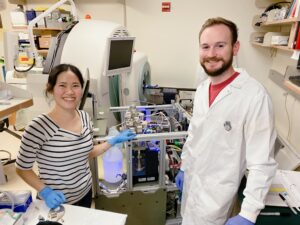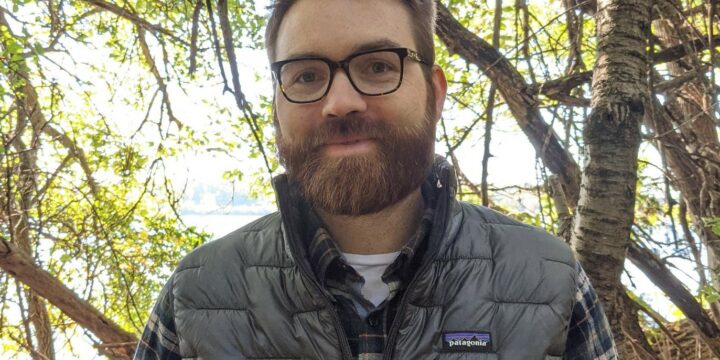Groundwater pollution project is first to use cancer imaging technology in novel way
May 19, 2022
By Marie Zhuikov
A Wisconsin Water Resources Institute project is exploring how bacteria and other water contaminants flow through soil by applying a medical technology widely used for cancer imaging.

Chris Zahasky, assistant professor in the Department of Geoscience at the University of Wisconsin-Madison, received two years of funding to study soil types in the two most vulnerable geologic settings in Wisconsin for groundwater pollution. Those are the Central Sands district, which features sandy soil, and Kewaunee County along Lake Michigan, which features fractured bedrock. Zahasky is investigating how E. coli bacteria – one of the main water contaminants in Wisconsin – percolates through the soil and ends up polluting groundwater and people’s private wells.
His research team hypothesizes that flow of contaminated water though soil that’s highly permeable leads to bacterial contamination of groundwater at greater distances from the pollution source than what was thought possible based on previous laboratory measurements in more stable, homogeneous geologic materials.
“With a better understanding of these transport and travel pathways, we can build better models to understand and manage the risks associated with these contaminants,” Zahasky said. “We all know the source of bacteria and nitrate. In Wisconsin, it’s largely from certain agricultural activities. Ideally, we can make better decisions about the times of the year that you might do manure spreading or certain geologic setting that shouldn’t have manure spread on them because of the ability for these bacteria to travel through this material and get down to the groundwater.”
Zahasky and his team are conducting their research in the lab with soil samples they’ve gathered from the Central Sands area and Kewaunee County. They measure the soil’s properties, then pack it into large tubular columns and inject water through the material in a controlled manner. Then they add bacteria they’ve grown and pump them into the columns.
This is where the cancer imaging technology comes in. It’s called positron emission tomography (PET). In medical situations, doctors use PET with radio tracers to identify tumors in the body. It’s also used in some cases for cancer therapy treatment. The radio tracers are basically radioactive sugar molecules. Cancer tumor cells have a high metabolism and so they uptake (eat) these sugar molecules at a higher rate than other cells in the body, which is what the PET ends up imaging.

Zahasky explained how this works for his purposes. “We leverage that imaging technique by radio labelling these bacteria, which means that we attach these radioactive isotopes to the bacteria that are emitted as they travel through these columns. As we’re imaging them, we can essentially track where these bacteria are going, how fast they’re getting there and where they’re getting stuck.
“We’re the first people in the world to radio label bacteria for environmental and geologic purposes. We’re pretty excited about this,” Zahasky said.
How do they attach radioactive isotopes to tiny bacteria? Zahasky said it’s not complicated. “We grow the bacteria until just the right point – where they’re starting to get hungry. Then we add this radio-labeled sugar and they just gobble it up. The bacteria eat the sugars just like tumor cells do.”
Zahasky developed this approach during his Ph.D. work at Stanford University. However, many of the isotopes required for this imaging are produced at the University of Wisconsin Cyclotron Lab. So, it made sense for him to continue his research at UW-Madison, where he has built capability with support from a National Science Foundation grant.
“It allowed my research group to leverage this type of imaging in lots of new ways that just weren’t possible without having access to these facilities here on campus,” he said.
Zahasky plans to apply this technique to future studies involving the movement of microplastics and other contaminants such as heavy metals.




